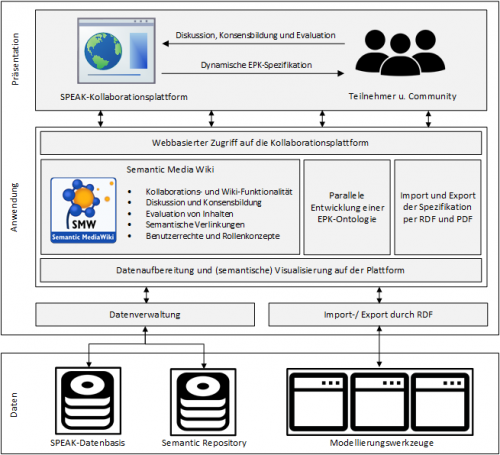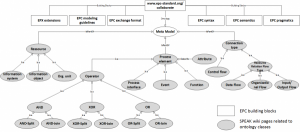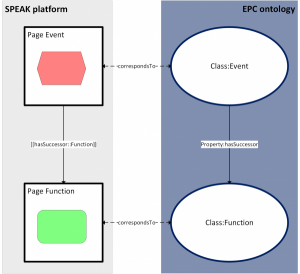Collaborative Specification Engineering - How To
From EPC Standard
In this section, participants interested in actively supporting EPC standard-making are provided with additional details regarding the general standardization procedure and its organisation. For further information, please feel free to contact the SPEAK project team.
Collaborative Specification Engineering
Successful standard-making requires agreement and consensus of a particular community about features, characteristics and details of the subject to be standardized. In order to facilitate the standard-making procedure, the SPEAK project team has set up a web-based platform to collaboratively specify the EPC language. While doing so, the platform and all elaborated contens remain open for public access, ensuring a broad consensus of participants coming from various domains about aspects iof the event-driven process chain.
Besides laying ground for a successful standard-making, the provided platform additionally elaborates on the standardization procedure with specific focus on business process modelling languages in general.
Speak Architecture
The figure visualizes the architecture of the SPEAK collaboration platform, which is divided into three basic architectural layers. On the lowest data layer, the data management and external application systems are located. In the context of the SPEAK collaboration platform, the management of the wiki's data, which includes both content-related information such as text, graphics and usage-related information such as log-on data, should be mentioned in this context. The semantic aspects of the SMW core of the platform are stored in a separate semantic repository. Here are u.a. manages the triplet relationships <ontology class> + <semantic annotation> + <ontology class>. Modeling tools are listed as part of the data layer because such systems can be used to import and export language-relevant structures in RDF format. The application layer contains the system logic of the SPEAK platform. The central core of the platform-form is the SMW, through which both wiki functionalities and ontology properties can be used for the purpose of standardization. The application logic of the SMW is enriched by self-developed software plug-ins, the .u. allow page content to be reconciled through a rating system. At the same time, an export function was developed so that the contents specified in the platform format can be exported at the press of a button both in machine readable RDF format and in PDF format. Access to the collaboration platform is web-based, enabling platform-independent participation in the SPEAK specification process. Accordingly, the presentation layer is primarily represented by the web interface of the collaboration platform. In addition, the specification activities of the participants are located at this top level. Within the open platform, registered users can actively participate in the specification by creating or editing Wi-ki pages. Through discussion, feedback and evaluation functions, a consensus can be formed that reflects the substantive understanding of the essential language components of the EPC community.
Platform structure
The platform structure reflects components that have to be considered when standardizing any given modelling language. The main page serves as a brief summary of the current state of EPC specification and thus summarizes content of all its sub-pages. In total, there are seven main components, so called building blocks, that constitute the EPC language specification. These building blocks are characterized in the following:
- Syntax
- A syntax defines language rules, which ensure the construction of sound EPC models. This platform facilitates both a formal syntax of the EPC as well as an ontology-driven specification via semantic linkage of pages.
- Semantics
- Language semantics refer to behavioural aspects of EPC elements. Again, both formal and ontology-based semantics can be created using platform features.
- Pragmatics
- In essence, pragmatic quality represents to what degree a user is able to comprehend a given model. This includes, for example, guidelines of how to create EPC models with high pragmatic quality or naming conventions of EPC model elements.
- Meta Model
- The EPC meta model describes relationships between EPC model elements. Since a meta model serves as a general starting point for syntactical issues, all elements included in the meta model section have been assigned with semantic annotations to further specify their interconnection.
- Exchange Format
- To exchange and store EPC models, an appropriate format needs to be defined. Accordingly, this section discusses previous attempts of defining an EPC exchange model and aims at specifying a new one.
- Modelling Guidelines
- Strongly related to Pragmatics, modelling guidelines support EPC modellers to create sound, yet comprehensible EPC models. Supporting this issue, this building block is further divided into pattern, use cases and reference models to be included in an EPC standard.
- Extensions
- Over the years, the EPC language has been extended in various forms. This building block introduces the most relevant language extensions and discusses a potential integration.
Each building block is again divided into sub-pages. Exemplarily, the meta model building block consists of process, process elements, resources, process interface and relation types. Primarily, the specification of the EPC language is done on these sub-pages. The superordinate pages then serve as a summary of the underlying parts. However, there are building blocks that are not subdivided. Here, the specificaton of contents is done directly on the respective page.
Semantic annotations
One of the core features of the platform is its semantic foundation. Using the concept of ontologies as an underlying schema, the platform and all pages of the "Meta model" category are based on an ontology-based model reflecting the structure of the EPC language.
Just like ontology classes are linked via semantic properties, features of the Semantic Media Wiki enable the user to create such properties with pages as well. As shown in the figure, each page is treated as an own ontology class. Semantic annotations can be used to link pages in cases there is a connection on the syntax level of the EPC. The semantic link established is immediately reflected on the ontology-level, creating a property between the ontology class representations of these pages.
Linking pages may be used to further specify the relationships between language elements, thus detailing syntax an semantic of the EPC. Exemplarily, the "Event" page has a semantic property "is predecessor" to both the "Function" page and the "Operator" page. This semantic connection indicates that the EPC process element "Event" may only be preceded by the process element "Event" or any kind of "Operator", thus prohibiting any other process element from preceding an "Event". Main benefits of applying ontologies for EPC standardization are
- exploring an alternate form of specifying syntax and semantics of a business process modelling language beside formal specification
- being able to directly transfer the results of the standization process to a visualizable form (EPC ontology)
- providing a machine-readable specification of EPC syntax and semantics that can be accessed by any software via semantic web
To define and set semantic properties, relevant pages include a seperate information box. Participants of the standardization process may define new links between pages using existing properties. However, you may also request new semantic properties.
Participation
For actively participating in the EPC standardization process, some key steps are required. In the following, a brief outline of these steps is given in order to provide a guideline for interested visitors.
Log In
To create and edit content, your first step is to register with the platform. For doing so, use this link. Information about the E-mail adress and the real name for creating user account are optional. However, we recommend to provide a valid E-mail, since the validation of your registration will be ensued based on the given adress. Additionally, there may be status updates or important information send via newsletter. After successful Log In, you are able to contribute according to your assigned user rights.
Create and edit content
After registration, users are able to create content in accordance to their assigned user rights. Possible content creation can range from updates on existing pages, for example new paragraphs or images, to new pages. For editing existing pages, you may use the "Edit" button on top of your screen. Additionally, every chapter has its own "Edit" function, which you can use in case your changes only adress this particular chapter. For creating new pages, you may use the search bar to query for your desired page (e.g. "Apple"). A dialog will appear, which informs you that the particular page has not been created yet. Subsequently, the platform enables you to create the page yourself and fill in its content. Remember linking your newly created page properly, otherwise other users will not be able to review it. For changing an image, just click on the image to be changed and upload your new version.
Key characteristic of the platform is its use of addtiomal element semantics. The platform ist based on Semantic Media Wiki, a Media Wiki extension enhanced with additional feature for semantic annotations. Pages covering essential EPC modelling elements additionally visualize the current state of semantic linkage via properties known from ontologies. To edit the properties, there is a special "Edit" button below the "Properties" box. Here, you are able to edit or create semantic links between EPC model elements represented via platform pages. If there is a need for a new semantic property not yet considered, you may open a page discussion and elaborate on your proposal.
If there are questions regarding the use of (Semantic) Media Wiki-specific syntax, e.g. for linking pages, please visit
- https://en.wikipedia.org/wiki/Help:Link for using regular Media Wiki functionality
- https://www.semantic-mediawiki.org/wiki/Help:User_manual for semantic extensions provided by Semantic Media Wiki
Please keep in mind that with most user rights, your actions will not be visible immediately. Unless you only add minor details, administrators/bureaucrats will open your changes fo public discussion. Provided their has been reached consensus about your contribution, the aforementioned user groups will approve the new content, thus publishing it as an official part of the platform.
Discussion and consensus
Standardization is fundamentally based on agreement and consensus. Therefore, the SPEAK platform provides means for participants to reach such a consensus about aspects of the EPC language. The current state of the platform enables users to discuss content by opening a new discussion page, which is subsequently assigned to the respective content page the discussion is about. Being a prominent feature of popular Wikis (e.g. Wikipedia), the discussion feature aims at bringing different perspectives together with the ultimate goal to reach an agreement over the content covered in a platform page. A discussion may be opened or edited for the following reasons:
- You identified an error on an existing page
- You would like to propose a suggestion or improvement (e.g. the shape and color of the "Event" process element)
- You want to participate in an ongoing debate and would like to carry out your argument
To open a discussion, just click on the "Page" button on top of your screen and select "Discussion". Afterwards, you are able to edit and save the discussion page just as you do with every other content page. Users, who have marked a particular page will receive a notification about changes on the discussion page. The discussion procedure provides that proposals or suggestions will be left open for discussion for a determined time frame. If there is major consensus on the discussed issues, the proposed changes will integrated into the content page and approved as a the current final state.
User rights
One of the platform's main features is the public availability of contents. Unregistered visitors are assigned to the "User" group. able to browse through the pages and read content. For active participation, a user account is required. After creating a new user account, you will be automatically assigned to the "Registered Users" group. This group is allowed to participate in discussions, upload new images and edit existing pages. Please note that your edits need to be reviewed before they are published. Participants with exhaustive domain knowledge in the field of EPCs will be assigned "Domain Experts" group. This group therefore you can create new pages, alter existing images, send mails to other users, mark your edits as "minor" (so they do not have to be reviewed) and review edits from other users. The highest non-administrative group are "Bureaucrats" that hold rights to validate and approve edits from other users and set user rights. If you are interested in supporting the management of the EPC standardization process, please contact us.
| User group | User rights |
|---|---|
| Unregistered Users |
|
| Registered Users |
|
| Domain Experts |
|
| Bureaucrats |
|


